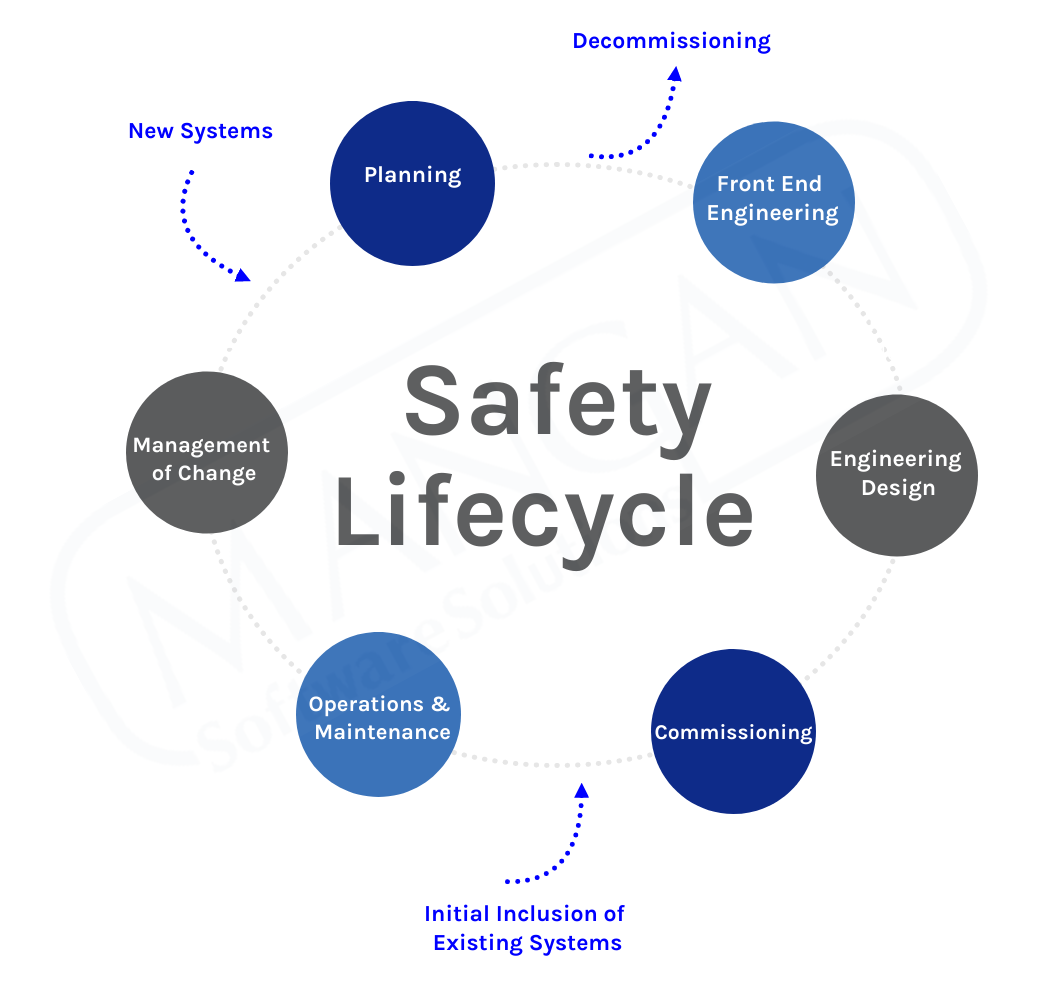Digitalization Demands An Integrated Safety Lifecycle Management System (part 1)

An integrated safety lifecycle management system is crucial to properly manage the entire safety lifecycle from cradle to grave. Anyone who has attempted to manage the Safety Lifecycle has quickly realized that the tools that a typical processing facility uses are wholly unsuited to meet the requirements of the Safety Lifecycle.
Most tools available are single purpose and don’t exchange or share information. The tools available are directed towards managing things such as costs, labor management, warehouse inventory management, and similar business-related functions. The systems upon which these functions are based generally use a rigid hierarchy of data relationships and have little flexibility.
An Integrated Safety Lifecycle Management program must supplement or replace the traditional tools to even be considered. Otherwise, the result is a mix of paper files (or image files on network drives)and a variety of independent word processor and spreadsheet files. Not to mention the procedures for data collection that fall outside of what the traditional plant management tools will do. This places an unreasonable and unsustainable burden on plant personnel. These systems may be forced to work for awhile, but don’t perform well over time. Also, its necessary to consider changes of personnel in various positions that occur.
Safety Lifecycle Management
The Safety Lifecycle is a continuous process that originates with the conceptual design of a processing facility and continues throughout the entire service life of that process. Process Safety related functions start their life during the initital Hazard Assessments when potential hazards and their consequences are evaluated. Protective functions are designed to prevent the consequences of the hazards from occurring and their lifecycle proceeds through design, implementation and operation. As plant modifications occur, the existing functions may need to be modified,may be found to no longer be necessary, or new functions are identified as being required. This results in another trip through the lifecycle as illustrated below.

The Safety Lifecycle IEC Regulations
IEC 61511, defines the processes that are to be followed when developing, implementing and owning of Safety Instrumented Systems (SIS). While the scope of IEC 61511 is limited to SIS, the concepts also apply to other Protective Functions that have been identified such as Basic Process Control Functions, Interlock, Alarms or physical Protective Functions such as barriers, drainage systems, vents and other similar functions.
The Safety Lifecycle as described in IEC 61511 is shown in the figure below. This figure has been excerpted from IEC 61511 and annotated to tie the various steps with how Process Safety Work is typically executed. These major phases represent work that is often executed by separate organizations and then is passed onto the organizations responsible for the subsequent phase.

1.) Requirements Identification
This phase involves conducting Process Hazards Analyses and identifying the Protective Functions required to avoid the consequences of process hazards from occurring.
The tools typically used for these activities are a Process Hazards Analysis application and Layers of Protection Analysis (LOPA). The CCPS publication Layer of Protection Analysis: Simplified Process Risk Assessment describes the process of identification and qualification of Protective Functions, identified as Independent Protection Layers (IPL’s).
2.) Specification, Design, Installation and Verification
This phase is typically thought of as “Design”, but it is so much more:
- The Specification phase is involving specification of the functional requirements for the identified IPL’s. When the IPL’s are classified as Safety Instrumented Functions (SIF), they are defined in a Safety Requirements Specification as defined by IEC 61511. Other non-SIF IPL’s are defined as described in the CCPS LOPA publication, although the concepts defined in IEC 61511 are also an excellent guide.
- Once requirements are specified, physical design is performed. The design must conform to the functional, reliability and independence requirements that are defined in the SRS or non-SIF IPL requirements specifications.
- The designs of the Protective Functions are installed and then are validated by inspection and functional testing. For SIS’s a Functional Safety Assessment as described by IEC 61511 is performed prior to placing the SIS into service.
3.) The Ownership Phase
This is the longest duration phase, lasting the entire life of the process operation. This phase includes:
- Operation of the process and its Protective Functions. This includes capture of operational events such as Demands, Bypasses, Faults and Failures.
- Periodic testing of Protective Functions at the intervals defined by the original SRS or IPL requirements. This involves documentation of test results and inclusion of those results in the periodic performance evaluations.
- Periodic review of Protective Function performance and comparison of in-service performance with the requirements of the original SRS or IPL requirements. If performance is not meeting requirements of the original specifications, identification and implementation of corrective measures is required.
- Management of Change in Protective Functions as process modifications occur during the process lifetime. This starts a new loop in the Safety Lifecycle where modifications, additions or deletions of Protective Functions are identified, specified and implemented.
- Final decommissioning where the hazards associated with decommissioning are assessed and suitable Management of Change processes are applied.
CLICK HERE TO READ MORE ON ⇨ A Holistic Approach to the Safety Lifecycle
Execution Challenges
Execution of the Safety Lifecycle interacts with numerous process management tools. Some of those tools that are typically available are illustrated in the figure below. All of these tools have the characteristics that they are generally suitable for the single purposes for which they were chosen, but all of them have limitations that make them unsuitable for use with a Safety Lifecycle Management process.
The Safety Lifecycle involves numerous complex relationships that cross traditional organizational boundaries and require sharing of data across these boundaries. The tools traditionally used in process operational management just don’t fit the requirements of Managing the Safety Lifecycle. Attempts to force fit them to Safety Lifecycle Management results in fragmented information that is difficult to access and maintain or which is just missing, and which results in excessive costs and highly ineffective Safety Lifecycle Management. The work around become so fragmented and complex, they rapidly become unsustainable.

-
The Value of an Integrated Safety Lifecycle Management System
An Integrated Safety Lifecycle Management System provides the benefits that an organization expects from the protective systems installed in a facility. The System provides fit for purpose work processes that account for the multiple relationships among the various parts of the Safety Lifecycle that traditional tools do not provide. A few of the high-level benefits are:
- Consistency and quality of data is vastly improved by using common processes, data selection lists, data requirements and procedures that have been thought out and optimized for the needs of managing protective systems.
- Design of Protective Functions is made much more efficient due to standardization of the information needed and the ability to copy SRS and non-SIF IPL data from similar applications that exist elsewhere in an organization. Design data is readily available to all authorized Users that need that data.
- Process Safety awareness is enhanced because the Safety Lifecycle Management System provides links between the originating hazard assessments, PHA Scenarios, LOPA’s, LOPA IPL’s and the Plant Assets used to implement the Protective Functions. Authorized users can readily identify Protective Functions and Plant Assets that implement them, and directly access the process hazards for which the functions were installed to prevent.
- Protective Function and associated Plant Asset performance events can be readily captured with a minimum of effort. The Safety Lifecycle Management System collects all of the event data and automatically produces performance data such as Tests Overdue, Tests, Failure Rates, Tests Upcoming, Demand Rates, Failure Rates and Prior Use statistics on a real time basis. The performance can be reported on a Unit, Site or Enterprise basis and can be categorized by Protective Function type, Device Type, Device manufacturer or similar categories. This allows Users to fully understand the conformance of Protective Function and Device performance relative to their Safety Requirements and identify any performance issues.
Rick Stanley has over 45 years’ experience in Process Control Systems and Process Safety Systems with 32 years spent at ARCO and BP in execution of major projects, corporate standards and plant operation and maintenance. Since retiring from BP Rick has consulted with Mangan Software Solutions (MSS) on the development and use of MSS’s SLM Safety Lifecycle Management software and has performed numerous Functional Safety Assessments for both existing and new SISs.
Rick has a BS in Chemical Engineering from the University of California, Santa Barbara where he majored in beach and minored in Chemical Engineering… and has the grade point to prove it. He is a registered Professional Control Systems Engineer in California and Colorado. Rick has served as a member and chairman of both the API Subcommittee for Pressure Relieving Systems and the API Subcommittee for Instrumentation and Control Systems.